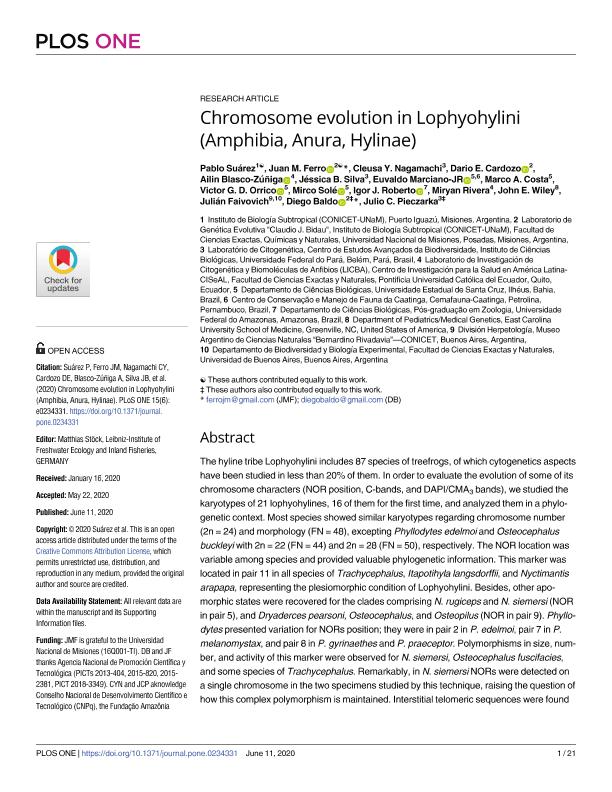Artículo
Chromosome evolution in lophyohylini (amphibia, anura, hylinae)
Suarez, Pablo ; Ferro, Juan Martín
; Ferro, Juan Martín ; Nagamachi, Cleusa Y.; Cardozo, Dario Elbio
; Nagamachi, Cleusa Y.; Cardozo, Dario Elbio ; Blasco zuñiga, Ailin; Silva, Jéssica B.; Marciano Jr, Euvaldo; Costa, Marco A.; Orrico, Victor G.D.; Solé, Mirco; Roberto, Igor J.; Rivera, Miryan; Wiley, John E.; Faivovich, Julián
; Blasco zuñiga, Ailin; Silva, Jéssica B.; Marciano Jr, Euvaldo; Costa, Marco A.; Orrico, Victor G.D.; Solé, Mirco; Roberto, Igor J.; Rivera, Miryan; Wiley, John E.; Faivovich, Julián ; Baldo, Juan Diego
; Baldo, Juan Diego ; Pieczarka, Julio
; Pieczarka, Julio
 ; Ferro, Juan Martín
; Ferro, Juan Martín ; Nagamachi, Cleusa Y.; Cardozo, Dario Elbio
; Nagamachi, Cleusa Y.; Cardozo, Dario Elbio ; Blasco zuñiga, Ailin; Silva, Jéssica B.; Marciano Jr, Euvaldo; Costa, Marco A.; Orrico, Victor G.D.; Solé, Mirco; Roberto, Igor J.; Rivera, Miryan; Wiley, John E.; Faivovich, Julián
; Blasco zuñiga, Ailin; Silva, Jéssica B.; Marciano Jr, Euvaldo; Costa, Marco A.; Orrico, Victor G.D.; Solé, Mirco; Roberto, Igor J.; Rivera, Miryan; Wiley, John E.; Faivovich, Julián ; Baldo, Juan Diego
; Baldo, Juan Diego ; Pieczarka, Julio
; Pieczarka, Julio
Fecha de publicación:
06/2020
Editorial:
Public Library of Science
Revista:
Plos One
ISSN:
1932-6203
e-ISSN:
1932-6203
Idioma:
Inglés
Tipo de recurso:
Artículo publicado
Clasificación temática:
Resumen
The hyline tribe Lophyohylini includes 87 species of treefrogs, of which cytogenetics aspects have been studied in less than 20% of them. In order to evaluate the evolution of some of its chromosome characters (NOR position, C-bands, and DAPI/CMA3 bands), we studied the karyotypes of 21 lophyohylines, 16 of them for the first time, and analyzed them in a phylogenetic context. Most species showed similar karyotypes regarding chromosome number (2n = 24) and morphology (FN = 48), excepting Phyllodytes edelmoi and Osteocephalus buckleyi with 2n = 22 (FN = 44) and 2n = 28 (FN = 50), respectively. The NOR location was variable among species and provided valuable phylogenetic information. This marker was located in pair 11 in all species of Trachycephalus, Itapotihyla langsdorffii, and Nyctimantis arapapa, representing the plesiomorphic condition of Lophyohylini. Besides, other apomorphic states were recovered for the clades comprising N. rugiceps and N. siemersi (NOR in pair 5), and Dryaderces pearsoni, Osteocephalus, and Osteopilus (NOR in pair 9). Phyllodytes presented variation for NORs position; they were in pair 2 in P. edelmoi, pair 7 in P. melanomystax, and pair 8 in P. gyrinaethes and P. praeceptor. Polymorphisms in size, number, and activity of this marker were observed for N. siemersi, Osteocephalus fuscifacies, and some species of Trachycephalus. Remarkably, in N. siemersi NORs were detected on a single chromosome in the two specimens studied by this technique, raising the question of how this complex polymorphism is maintained. Interstitial telomeric sequences were found in P. edelmoi,P. melanomystax, and Osteocephalus buckleyi, and their presence seems to be not related to the chromosome reorganization events. Finally, some species showed spontaneous rearrangements, possibly as a consequence of an uncommon phenomenon in anuran cytogenetics: the presence of fragile sites or secondary constrictions not associated with NORs. We propose that this rare feature would have played an important role in the evolution of this group of frogs. From the evidence obtained in this and previous studies, we conclude that Lophyohylini presents a complex chromosome evolution.
Archivos asociados
Licencia
Identificadores
Colecciones
Articulos(IBS)
Articulos de INSTITUTO DE BIOLOGIA SUBTROPICAL
Articulos de INSTITUTO DE BIOLOGIA SUBTROPICAL
Articulos(MACNBR)
Articulos de MUSEO ARG.DE CS.NAT "BERNARDINO RIVADAVIA"
Articulos de MUSEO ARG.DE CS.NAT "BERNARDINO RIVADAVIA"
Citación
Suarez, Pablo; Ferro, Juan Martín; Nagamachi, Cleusa Y.; Cardozo, Dario Elbio; Blasco zuñiga, Ailin; et al.; Chromosome evolution in lophyohylini (amphibia, anura, hylinae); Public Library of Science; Plos One; 15; 6; 6-2020; 1-21
Compartir
Altmétricas



